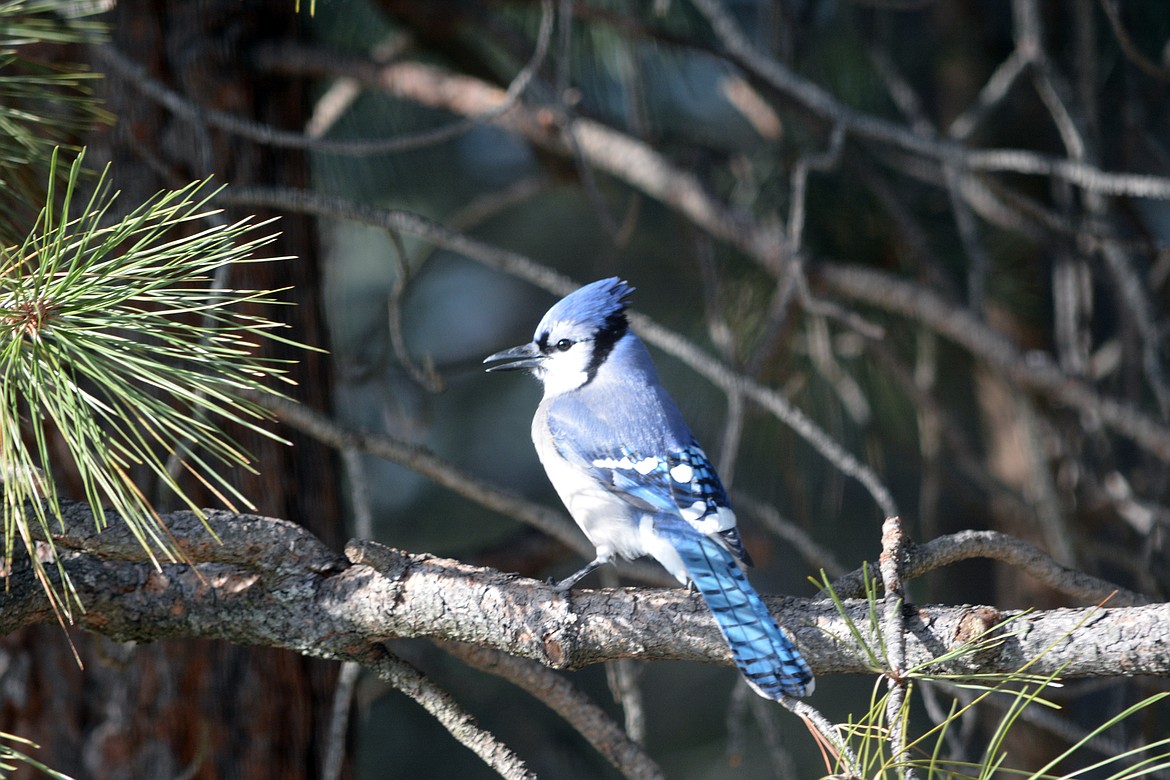Blue Jay or Steller’s Jay: That is the question
“These jays have similar personalities. Both are raucous and have a bit of a reputation for being ‘bad boys.’ They are as watchful as dogs, and that they neglect all other employment … to come round, follow, peep at and scold you.” — Thomas Nuttall, Nineteenth-century bird observer.
I was alerted one morning by a blue flash in my backyard and heard a piercing “jaay, jaay, jaay” sound. I wondered if it could be a “blue jay”!
I couldn’t believe it until I looked out the window to see a blue jay perched on a ponderosa pine branch; it was the second year they have come to our yard. Later that day a pair of Stellar’s jays also arrived in search of food.
The blue jay’s scientific name, Cyanocitta cristata, refers to its blueness. The genus comes from cysnos, the Greek word for blue; the species name is the Latin cristata, meaning “crested.” Jays are members of the Corvidae family, which also includes crows, ravens, magpies, and several other species of jay and is considered by many to be the most intelligent family of birds, because of these birds’ capacity to solve problems.
Steller's jays, also known as Cyanocitta stelleri, are often confused with blue jays, because their tail, wings, and most of their body are a brilliant cobalt. But blue jays are blue and white, while Steller's jays are blue and black.
Blue jays call “jaay, jaay” in alarm and in flock emit a softer “toolool” which has an almost bell-like quality. They are also skilled imitators of hawks. Steller’s jays' most common call is a harsher “shaak, shaak, shaak.”
Steller’s and blue jays are the only North American jays with crests. Both are about 11-12 inches in size, with Steller’s being slightly larger. With its black hood and dark blue feathers, Steller’s is easy to distinguish from the blue jay, which has a light grayish chest and white spotting on the wings and tail.
If you only get a glimpse of bright blue before the bird takes flight, check out the tail feathers. Blue jays have a band of white showing there, while Steller’s is completely blue.
The Steller’s jay and the blue jay are the only North American jays that use mud in the construction of their nests. During courtship, the male jay chases the female. They prefer to nest in deciduous trees, with cottonwoods being a favorite locally. Both parents incubate the 4-5 brown spotted buff eggs and both share the feeding of the nestlings for 11-17 days after the hatch.
Ritual feeding is part of the courtship for Steller’s. The male will also circle around the female in display. Both parents build the nest, preferring coniferous forests. The nestlings fledge after two-three weeks of parental care and the juveniles remain with the parents throughout the first winter.
Steller's jays are the bird version of that person aggressively shouting nonsense on the street corner. They're the roommate who eats the lunch you packed the night before, and then denies it. They're every loud-talking, pompous, kleptomaniacal person you know, rolled into one admittedly stylish bird.
As I observed, blue jays and Steller’s harvest and store peanuts for later use. I wondered if they would recall where they stashed all of their bounty. I wonder if they only retrieve a portion of the peanuts they hide.
Blue jays and Steller’s jays are also not bashful about eating sunflower seeds, peanuts and suet from feeders whenever they have access to a perch.
Having adapted to the places where we live, they come readily to bird feeders and are bold about asking for handouts.
Enjoy the beauty of Boundary County and its wildlife.



